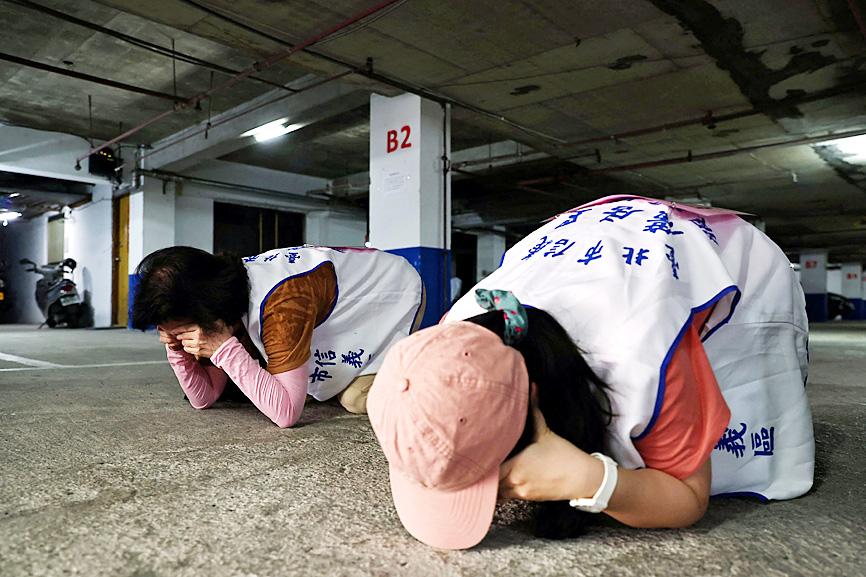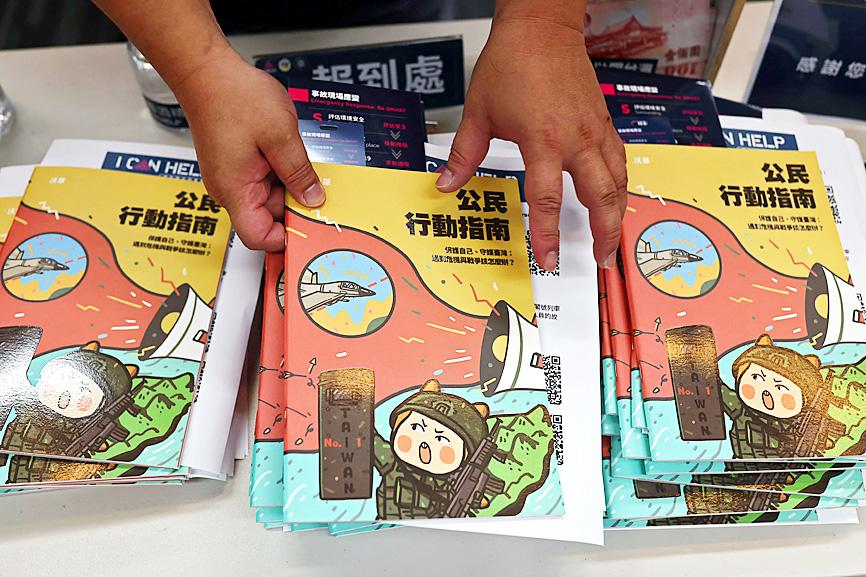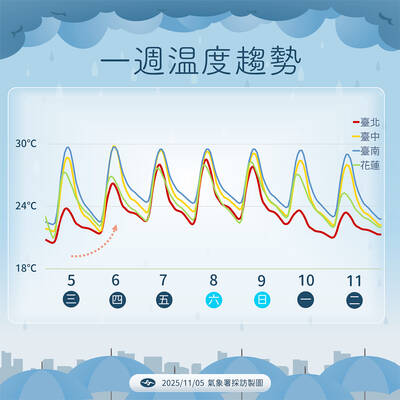Taiwan is preparing air-raid shelters as rising tension with China and Russia’s invasion of Ukraine raise new fears about the possibility of a Chinese attack.
China has in the past few years increased military activity in the air and seas around Taiwan, which vows to defend itself and has made strengthening its defenses a priority, with regular military and civil defense drills.
The preparations include designating shelters where people can take cover if Chinese missiles start flying in — not in purpose-built bunkers, but in underground spaces like basement car parks, the subway system and subterranean shopping centers.

Photo: Ann Wang, Reuters
Taipei has more than 4,600 such shelters that can accommodate about 12 million people, more than four times its population.
Harmony Wu, 18, was surprised to learn that an underground shopping concourse where she and other youngsters were recently rehearsing some dance moves would be turned into an air-raid shelter in the event of war.
However, she said she could understand why.

Photo: Ann Wang, Reuters
“Having shelter is very necessary. We don’t know when a war might come and they are to keep us safe,” Wu said. “War is brutal. We’ve never experienced it, so we aren’t prepared.”
Taipei officials have been updating their database of designated shelters, putting their whereabouts on a smartphone app, and launching a social media and poster campaign to make sure people know how to find their closest one.
Shelter entrances are marked with a yellow label, about the size of an A4 piece of paper, with the maximum number of people it can take.

Photo: Ann Wang, Reuters
A senior official in the city office in charge of the shelters said events in Europe had brought a renewed sense of urgency.
“Look at the war in Ukraine,” Taipei City Construction Management Office official Abercrombie Yang said.
“There’s no guarantee that the innocent public won’t get hit,” he said, adding that that was why the public had to be informed. “All citizens should have crisis awareness... We need the shelters in the event of an attack by the Chinese communists.”
Last month, Taiwan held a comprehensive nationwide Han Kuang military exercise for the first time since the COVID-19 pandemic disrupted regular drills.
Among the instructions citizens received in case of incoming missiles was to get down in their basement parking lots with their hands covering their eyes and ears while keeping their mouths open — to minimize the impact of blast waves.
Some civil defense advocates say more needs to be done.
Authorities are required by law to keep the shelters clean and open, but they do not have to be stocked with supplies like food and water.
Researchers in the Legislative Yuan in June called for shelters to be provided with emergency supplies.
Democratic Progressive Party Legislator Enoch Wu (吳怡農) said the public must prepare survival kits to take with them when they seek shelter.
“What’s important is what you bring with you, for people to stay there for a long period of time,” Wu said, citing medical supplies and even tools to build a makeshift toilet.
After decades of saber-rattling across the Taiwan Strait, many Taiwanese appear resigned to living with the threat of a Chinese invasion.
“I’m not stressed. I carry on with my life as usual. When it happens, it happens,” said Teresa Chang, 17, who was also going through her paces at the underground dance practice.

Three Taiwanese airlines have prohibited passengers from packing Bluetooth earbuds and their charger cases in checked luggage. EVA Air and Uni Air said that Bluetooth earbuds and charger cases are categorized as portable electronic devices, which should be switched off if they are placed in checked luggage based on international aviation safety regulations. They must not be in standby or sleep mode. However, as charging would continue when earbuds are placed in the charger cases, which would contravene international aviation regulations, their cases must be carried as hand luggage, they said. Tigerair Taiwan said that earbud charger cases are equipped

Foreign travelers entering Taiwan on a short layover via Taiwan Taoyuan International Airport are receiving NT$600 gift vouchers from yesterday, the Tourism Administration said, adding that it hopes the incentive would boost tourism consumption at the airport. The program, which allows travelers holding non-Taiwan passports who enter the country during a layover of up to 24 hours to claim a voucher, aims to promote attractions at the airport, the agency said in a statement on Friday. To participate, travelers must sign up on the campaign Web site, the agency said. They can then present their passport and boarding pass for their connecting international

UNILATERAL MOVES: Officials have raised concerns that Beijing could try to exert economic control over Kinmen in a key development plan next year The Civil Aviation Administration (CAA) yesterday said that China has so far failed to provide any information about a new airport expected to open next year that is less than 10km from a Taiwanese airport, raising flight safety concerns. Xiamen Xiangan International Airport is only about 3km at its closest point from the islands in Kinmen County — the scene of on-off fighting during the Cold War — and construction work can be seen and heard clearly from the Taiwan side. In a written statement sent to Reuters, the CAA said that airports close to each other need detailed advanced

UNKNOWN TRAJECTORY: The storm could move in four possible directions, with the fourth option considered the most threatening to Taiwan, meteorologist Lin De-en said A soon-to-be-formed tropical storm east of the Philippines could begin affecting Taiwan on Wednesday next week, the Central Weather Administration (CWA) said yesterday. The storm, to be named Fung-wong (鳳凰), is forecast to approach Taiwan on Tuesday next week and could begin affecting the weather in Taiwan on Wednesday, CWA forecaster Huang En-hung (黃恩鴻) said, adding that its impact might be amplified by the combined effect with the northeast monsoon. As of 2pm yesterday, the system’s center was 2,800km southeast of Oluanbi (鵝鑾鼻). It was moving northwest at 18kph. Meteorologist Lin De-en (林得恩) on Facebook yesterday wrote that the would-be storm is surrounded by